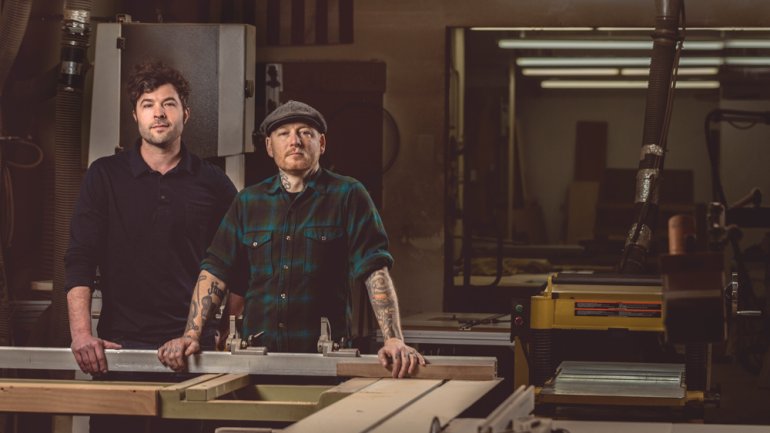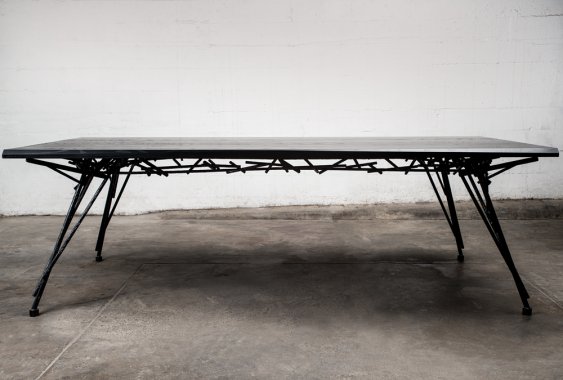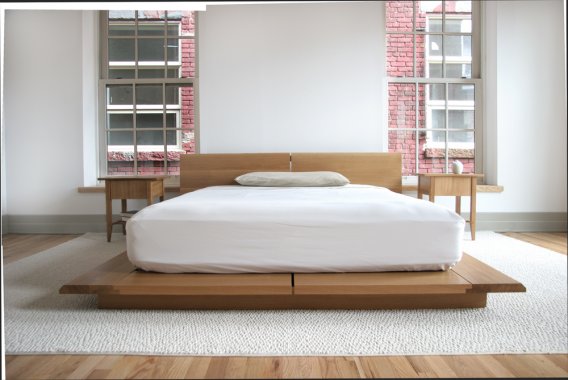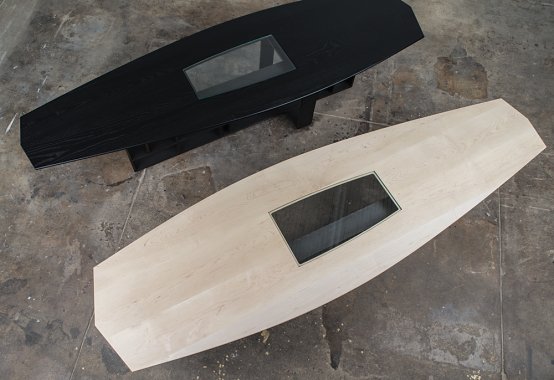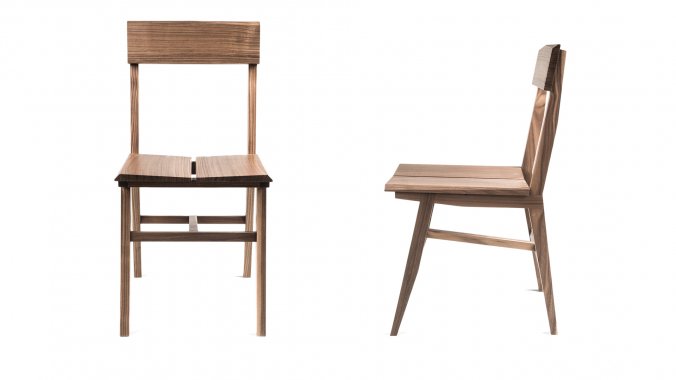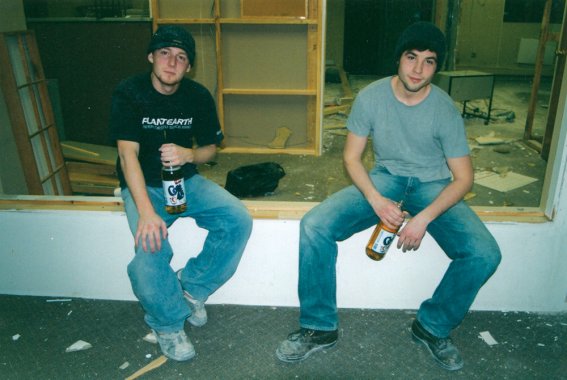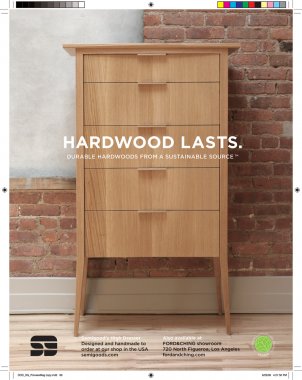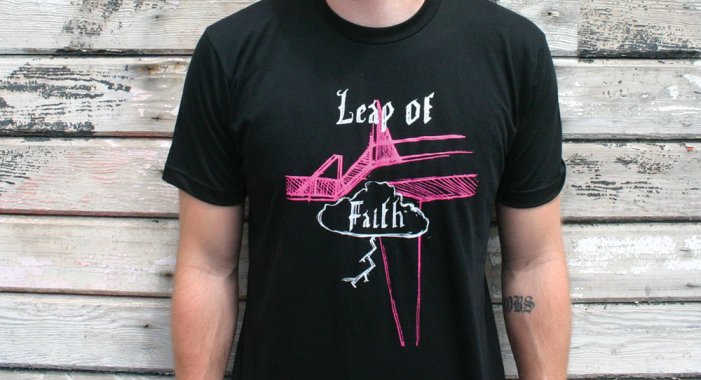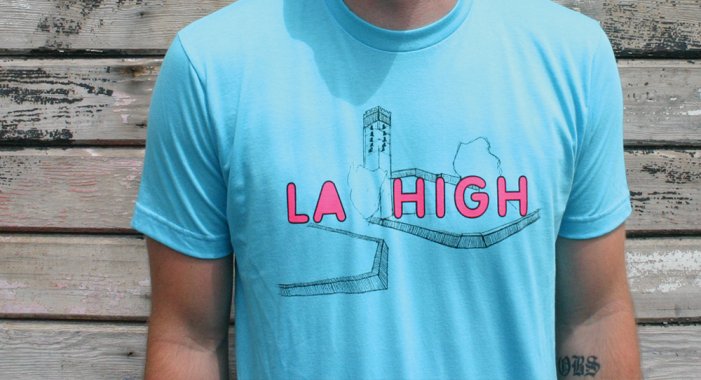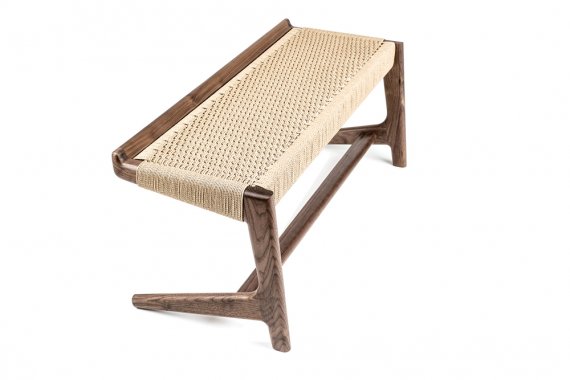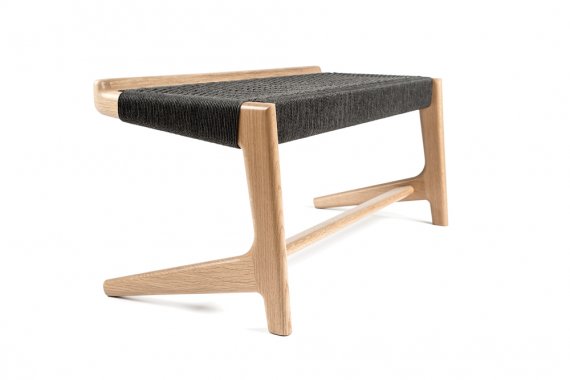Two Halves of a Whole
Two Halves of a Whole
Semigood Design makes furniture to live with easily, anywhere, forever. Sleek and modern, with hints of sculpture and architecture – an artful taper here, a cantilever there – the company’s bespoke tables, chairs, dressers, and other products embody a balance of sturdiness and sophistication, refinement and verve, movement and control.
That harmony is a reflection of the unique partnership of Thom Jones and Brendan Callahan, the duo behind Semigood. Jones, who crafts the pieces out of hardwood and steel in his basement studio in downtown Seattle, is a tattooed, Harley-riding live wire with a profanely funny delivery reminiscent of comedian Denis Leary (“You will understand quickly in this interview that I do swear a lot. I apologize for that s---,” he says with a laugh). Callahan, a graphic designer with a thoughtful manner, lives in the Bay Area and heads up visual communications for Semigood, in addition to his day job managing a design team at Google.
The longtime friends, both 39, admit their setup is unconventional. “You should probably remove any mental model of what a design studio should be when you’re talking about Semigood,” Callahan says, “because it’s just not that.” Based in different cities for more than a decade, the two get together with their wives and kids a few times a year, and they chat daily, though not always about work. Callahan directs the company’s image and brand – the photography, packaging, ads, all aspects of how it presents itself visually to the world. Jones is the guy “covered in sawdust.” Still, their collaboration is total.
“There would be no Semigood Design without Brendan, and there would be no Semigood Design without me,” Jones says. “Whenever I hit a roadblock, it usually only takes a 30-minute phone call with Brendan before I see it from a completely different perspective. He’s a rock. He’s always gone back to the fundamentals of design, which is ‘Don’t make it about kitsch and gimmick and bulls--t trends. Just do solid work, and make a beautiful product.’ ” As Callahan describes their dynamic, “I’m probably more quiet and reserved, more calm in some areas. But then Thom’s blast of energy complements everything that we do. So we balance one another out.”
When they met as students at Parsons School of Design in New York in 2000, the two felt an instant bond. Jones was a reformed hell-raiser from the Seattle area who’d spent his teens as a skateboarder and graffiti artist (“partying, doing bad stuff, pushing the people who loved me to the brink of insanity”) before channeling his creative drive into a major in product design. He acquired a passion for woodworking in his freshman year and honed his craft in professional shops while he was in school, doing custom cabinetry and furniture for high-end interiors. Callahan came from the Boston area and like Jones, loved architecture and furniture – his father was a carpenter as well as a firefighter – but gravitated toward graphic design. They spent a summer traveling together in Europe drinking in all the art at museums and galleries and solidifying both their friendship and the foundation for what they wanted to do after graduation, as designers.
They launched Semigood informally in 2002 with two other designer friends, in a loft space in Brooklyn they gutted and renovated. The company’s tongue-in-cheek name was “basically us sticking our middle finger up at the design elite,” says Jones. They had two mottos: “We take craftsmanship seriously, not ourselves” and, “Semigood: It’s not half-bad.” While their initial concept was a multidisciplinary studio, furniture became the focus early on, after Jones made a handsome mortise-and-tenon piece called the Rift chair – “probably my favorite piece of furniture I’ve ever done, the first thing I ever really designed from thin air.” This blossomed into an entire Rift Collection, which made an acclaimed debut at the 2005 Brooklyn Designs fair, putting Semigood on the map.
When the other partners left to pursue their own ventures, Semigood became Callahan and Jones’ baby.
“We both knew what resonated with us – this idea of simplicity,” Callahan says of their vision for a furniture design company. “We wanted to have simple forms, beautiful, streamlined furniture, and products that could stand the test of time.”
Semigood’s path, however, was anything but simple those first few years, as the two young men navigated their personal lives and swings in the economy. Callahan moved to California in 2004, where he would go on to hold positions at such companies as Dwell magazine, Airbnb, and OpenTable. In late 2005, Jones went west, too, to Palm Springs, and put furniture making on hold to remodel homes (during that time he also restored woodwork on such midcentury modern architectural treasures as Richard Neutra’s Kaufmann House). When the desert housing market dried up in 2007, Jones settled in Seattle, where he turned his focus back to furniture and Semigood.
At the 2008 Dwell on Design expo in Los Angeles, the company introduced the Rian Collection, stunning blends of wood frame and woven Danish cord named for Jones’ wife. (“I figured it was the most beautiful thing I had ever produced, and I should probably name it after the most beautiful woman I had ever known.”) The series was lauded widely and featured in the prestigious survey book Once Upon a Chair, propelling Semigood’s reputation to new heights. That led to a lucrative venture into the fashion world, with Jones crafting hundreds of furniture pieces and fixtures for retail spaces around the US and overseas, notably Elie Tahari and Eileen Fisher.
Since then, Callahan and Jones have continued to branch off into new directions for Semigood, including one-off commissions that reach into the realm of sculpture. Jones now works with metal as much as wood, owing in part to his obsession with vintage motorcycles. In 2015, for the offices of Howard S. Wright – the construction company that built Seattle’s Space Needle – he made the Lift table, a 10-by-10-foot square of wood and glass that can be raised and lowered with the turn of a sailboat wheel. An engineering tour de force, the steel base also features two old Harley-Davidson sprockets and a 530 motorcycle chain. “It’s like a manual robot,” Jones says of his outrageous creation. “To me, to date, as a maker of motorcycles or furniture or whatever, that is hands-down my proudest moment. It flexes all the muscles I have.”
True to their early ambitions, the pair stay open to other mediums and disciplines. Jones has crossed over to TV, appearing as a judge on Framework, a furniture design competition on the Spike network. Callahan wants to explore ceramics and textiles, and dreams of big projects that encompass every aspect of their interests – a restaurant, say, where they could design the physical space, the furniture, the whole look and feel. “We love the extension of what furniture design can mean,” Callahan says. “What it comes down to for us is that ability to work together, no matter what. That’s built on trust and friendship first.”
Above all, they’ve helped each other keep the faith. “You really have to be in this because you love it that much. If you want to do what I do, then you better buckle the f--- up, because it’s going to get real, real fast,” Jones tells aspiring furniture makers of the sweat equity required to build a business. “You’ve got to be willing to fail and struggle and pull your boots up and climb out of that hole when you’re in it and say to yourself, ‘Someday this will all be worth it.’ ” Happily, he adds, “It’s no longer what I say to myself. It’s what I know.”


